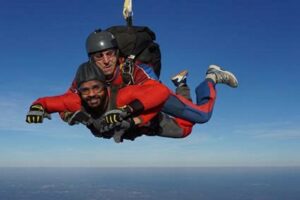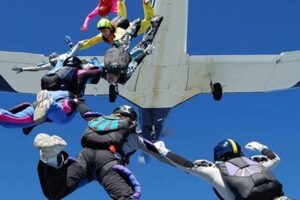Table of Contents
Skydiving Height Limit: Conquering the Skies from Exalted Altitudes
In skydiving, the height from which a jumper exits an aircraft is known as the “skydiving height limit.” Typically measured from the aircraft’s takeoff point to the jumper’s intended landing zone, this vertical distance dictates the duration of freefall and allows jumpers to experience the exhilarating sensation of flight. For instance, jumping from a height of 13,000 feet (3,962 meters) grants jumpers approximately 60 seconds of freefall before deploying their parachutes.
Skydiving from extreme heights holds immense significance for the sport. It presents jumpers with a unique blend of challenges and rewards, testing their physical and mental abilities while offering unparalleled views and an unforgettable sense of accomplishment. Historically, the pursuit of greater heights has been integral to the evolution of skydiving, with pioneers constantly pushing the boundaries to achieve new records. From Joe Kittinger’s record-breaking jump from 102,800 feet (31,333 meters) in 1960 to Felix Baumgartner’s stratospheric leap from 128,100 feet (39,045 meters) in 2012, these feats have captivated audiences worldwide.
This article delves into the fascinating world of skydiving height limits, exploring the reasons behind altitude restrictions, the meticulous planning and safety measures involved in high-altitude jumps, and the remarkable achievements of skydivers who have ventured to the very edge of the atmosphere. Get ready to embark on a journey through the clouds as we uncover the captivating stories and scientific principles that govern this thrilling sport.
Skydiving Height Limit
Skydiving height limits are crucial parameters that govern the safety and exhilaration of this thrilling sport. These limits are meticulously determined considering various essential aspects:
- Safety Regulations: Adherence to aviation and safety standards.
- Oxygen Availability: Ensuring sufficient oxygen levels at high altitudes.
- Equipment Limitations: Parachute deployment altitude and reliability.
- Jumper Experience: Skill level and training requirements for different heights.
- Weather Conditions: Impact of wind, temperature, and cloud cover.
- Legal Restrictions: Airspace regulations and permits for high-altitude jumps.
- Record-Breaking Attempts: Pushing the boundaries of human endurance and achievement.
Understanding these aspects is paramount for skydivers to make informed decisions, prioritize safety, and appreciate the technical intricacies of the sport. Skydiving height limits not only dictate the duration of freefall and the overall skydiving experience but also underscore the importance of meticulous planning, rigorous training, and a deep respect for the inherent risks involved.
Safety Regulations
In the realm of skydiving, safety regulations play a pivotal role in governing height limits and ensuring responsible participation in this adrenaline-fueled sport. These regulations encompass a comprehensive framework of guidelines and protocols aimed at minimizing risks and safeguarding the well-being of skydivers and others involved.
- Aircraft Maintenance: Regular inspections, certifications, and adherence to strict maintenance schedules are paramount to ensure the airworthiness of aircraft used for skydiving operations.
- Pilot Qualifications: Skydiving pilots undergo rigorous training and must possess the necessary skills, experience, and certifications to operate aircraft safely and effectively in skydiving environments.
- Parachute Requirements: Skydivers must use properly packed, inspected, and certified parachutes that meet industry standards and are suitable for the intended jump altitude and conditions.
- Jumper Training: Before embarking on a skydive, jumpers must undergo comprehensive training that covers proper techniques, safety procedures, and emergency protocols.
By adhering to these regulations, skydiving operators, pilots, and jumpers collectively contribute to a safer skydiving environment. These measures help prevent accidents, instill confidence among participants, and enable skydiving to be enjoyed as a thrilling and relatively low-risk sport.
Oxygen Availability
In the realm of skydiving, height limits are intricately intertwined with the availability of oxygen in the atmosphere. As skydivers ascend to higher altitudes, the air becomes thinner, resulting in a decrease in oxygen partial pressure. This phenomenon poses significant challenges that must be carefully managed to ensure the safety and well-being of jumpers.
- Hypoxia: At high altitudes, the reduced oxygen levels can lead to hypoxia, a condition characterized by an inadequate supply of oxygen to the body’s tissues. Symptoms of hypoxia can include impaired judgment, loss of coordination, and even unconsciousness.
- Oxygen Equipment: To mitigate the risks of hypoxia, skydivers at extreme altitudes often rely on supplemental oxygen systems. These systems typically involve breathing pure oxygen through a mask or nasal cannula, ensuring an adequate oxygen supply throughout the jump.
- Altitude Acclimatization: Prior to high-altitude jumps, skydivers may undergo a period of acclimatization, gradually ascending to higher elevations over several days. This allows their bodies to adapt to the lower oxygen levels and reduce the risk of experiencing hypoxia.
- Jump Planning: Skydivers carefully plan their jumps to minimize the time spent at high altitudes. They consider factors such as the aircraft’s climb rate, the intended jump altitude, and the duration of freefall to ensure they have sufficient oxygen throughout the jump.
The interplay between skydiving height limits and oxygen availability demands a comprehensive understanding of the physiological effects of high altitudes and the implementation of appropriate safety measures. Skydivers must receive proper training on oxygen systems, altitude acclimatization, and jump planning to ensure they operate within safe limits and mitigate the risks associated with oxygen deprivation.
Equipment Limitations
Within the exhilarating realm of skydiving, equipment limitations, particularly those pertaining to parachute deployment altitude and reliability, stand as critical factors inextricably linked to skydiving height limits.
The relationship between equipment limitations and skydiving height limits is primarily one of cause and effect. Parachutes, as the primary safety device in skydiving, are subject to physical constraints that dictate their effective deployment altitude and reliability. These constraints include:
- Deployment Altitude: Parachutes require a minimum deployment altitude to ensure sufficient time for inflation and stabilization before reaching the ground. This minimum altitude is influenced by factors such as the parachute’s design, weight, and intended use.
- Reliability: Parachutes, despite rigorous inspections and maintenance, are mechanical devices prone to malfunctions. The reliability of a parachute is affected by factors such as its age, condition, and packing techniques.
Given these limitat
ions, skydiving height limits are established to ensure that jumpers have ample altitude to safely deploy their parachutes and mitigate the risks associated with equipment failure. Real-life examples underscore the importance of considering equipment limitations when setting skydiving height limits:
- In 2016, a skydiver in California lost his life due to a parachute malfunction at a relatively low altitude. The jumper’s parachute failed to open properly, resulting in a fatal impact with the ground.
- In contrast, Felix Baumgartner’s record-breaking jump from the stratosphere in 2012 was meticulously planned to account for equipment limitations. Baumgartner ascended to an altitude of 128,100 feet (39,045 meters) and wore a specially designed suit to protect him from the extreme conditions. His parachute was also extensively tested and modified to ensure reliable deployment at such a high altitude.
Understanding the connection between equipment limitations and skydiving height limits has practical implications for skydivers and those involved in the sport’s regulation.
- Safety Regulations: Skydiving organizations and regulatory bodies establish height limits based on equipment capabilities and statistical data on parachute reliability.
- Training and Education: Skydivers receive comprehensive training on parachute deployment procedures, malfunction responses, and the importance of adhering to height limits.
- Equipment Maintenance and Inspection: Parachutes undergo regular inspections and maintenance to minimize the risk of failure. Skydivers are responsible for ensuring their equipment is in proper working condition.
In conclusion, equipment limitations, particularly those related to parachute deployment altitude and reliability, play a pivotal role in determining skydiving height limits. Understanding this relationship is essential for ensuring the safety of skydivers and maintaining the integrity of the sport.
Jumper Experience
In the exhilarating realm of skydiving, jumper experience plays a pivotal role in determining skydiving height limits. The level of skill and training required for a skydiver to safely execute a jump varies significantly depending on the intended jump altitude. This relationship between jumper experience and skydiving height limit stems from several key factors:
1. Freefall Time and Maneuvers: Higher jump altitudes result in longer freefall times, which demand greater skill and experience to maintain stability, control body position, and execute complex maneuvers. Inexperienced jumpers may struggle to handle the increased speed and disorientation associated with higher altitudes.
2. Oxygen Management: As skydivers ascend to higher altitudes, the air becomes thinner, leading to reduced oxygen levels. Managing oxygen effectively becomes crucial, especially for extended freefall times. Experienced jumpers are better equipped to monitor their oxygen levels and respond appropriately.
3. Emergency Procedures: High-altitude jumps carry inherent risks that require jumpers to be proficient in emergency procedures. Inexperienced jumpers may not possess the necessary skills and knowledge to respond effectively to malfunctions or other unforeseen circumstances.
Given these factors, skydiving organizations and regulatory bodies establish height limits based on jumper experience and training. Real-life examples illustrate the importance of this connection:
- Novice skydivers typically begin with jumps from lower altitudes (around 3,000-5,000 feet) under the supervision of an experienced instructor.
- As jumpers gain experience and demonstrate proficiency, they are gradually allowed to progress to higher altitudes with longer freefall times.
- Highly experienced skydivers, such as professional skydivers and record-breakers, may attempt jumps from extreme altitudes (above 10,000 feet), requiring specialized training and equipment.
Understanding the relationship between jumper experience and skydiving height limit has practical applications:
- Safety: Height limits help ensure that jumpers are adequately skilled and trained to handle the challenges associated with different altitudes.
- Progression: Gradual progression through height limits allows jumpers to develop their skills and confidence at a safe pace.
- Training: Skydiving schools and instructors tailor training programs to match the experience level and intended jump altitudes of their students.
In summary, jumper experience, encompassing skill level and training requirements, is a critical component of skydiving height limits. It influences the duration of freefall, oxygen management, and emergency preparedness, ultimately contributing to the safety and enjoyment of this thrilling sport.
Weather Conditions
In the realm of skydiving, weather conditions play a critical role in determining skydiving height limits. Wind, temperature, and cloud cover can significantly impact the safety and feasibility of a jump, necessitating careful consideration and adjustment of height limits accordingly.
Wind: Strong winds can affect a skydiver’s stability, control, and landing accuracy. High winds at ground level may prevent take-off or require adjustments to the jump plan to ensure a safe landing zone. At higher altitudes, strong winds can cause the parachute to drift significantly, posing challenges for jumpers to navigate and land precisely.Temperature: Temperature variations can impact the performance of parachutes and equipment. Extremely cold temperatures can stiffen parachute lines, affecting their deployment and stability. Conversely, hot temperatures can cause parachutes to open more quickly, requiring jumpers to be prepared for a rapid descent.Cloud Cover: Cloud cover can affect visibility and navigation for skydivers. Dense cloud cover can obscure landmarks and make it difficult to judge altitude and distance. In such conditions, skydiving height limits may be lowered to ensure jumpers have sufficient visibility to navigate safely.Real-life examples illustrate the impact of weather conditions on skydiving height limits:
- In 2019, a skydiving event in Arizona was canceled due to high winds, ensuring the safety of participants.
- During the Red Bull Stratos mission in 2012, Felix Baumgartner’s jump from the stratosphere was delayed due to concerns about wind conditions at the target landing zone.
- Cloud cover often necessitates adjustments to skydiving height limits, particularly in mountainous areas where visibility can be limited.
Understanding the connection between weather conditions and skydiving height limits has practical applications:
- Safety: Height limits are adjusted based on weather conditions to minimize risks and ensure the safety of skydivers.
- Decision-Making: Skydiving operators and pilots use weather forecasts and real-time observations to make informed decisions about jump altitudes and potential delays.
- Contingency Planning: Jump plans include contingency measures to address changing weather conditions, such as alternative landing zones or adjustments to jump procedures.
In summary, weather conditions, encompassing wind, temperature, and cloud cover, are critical components of skydiving height limits. They influence the safety, feasibility, and navigation of skydives, necessitating careful consideration and adjustment of height limits to ensure the well-being and enjoyment of participants.
Legal Restrictions
In the realm of skydiving, legal restrictions play a crucial role in governing skydiving height limits. These restrictions encompass airspace regulations and permit requirements, ensuring the safety, security, and orderly conduct of high-altitude jumps.
- Airspace Control: Airspace is a controlled resource, and skydiving activities must adhere to regulations set by aviation authorities. This includes obtaining necessary clearances, coordinating with air traffic control, and ensuring compliance with designated airspace boundaries.
- Permit Requirements: For high-altitude jumps, special permits may be required from relevant authorities, such as the Federal Aviation Administration (FAA) or local aviation agencies. These permits are granted after a thorough assessment of the jump plan, equipment, and safety measures in place.
- Safety Protocols: Legal restrictions often mandate specific safety protocols for high-altitude jumps, including minimum jump altitudes, oxygen requirements, and emergency procedures. These protocols are designed to minimize risks and ensure the well-being of skydivers.
- Liability and Insurance: Legal restrictions also address liability and insurance requirements for skydiving operators and participants. This ensures that proper insurance coverage is in place to protect individuals and organizations involved in high-altitude jumps.
The interplay between legal restrictions and skydiving height limits is multifaceted. These restrictions serve as a framework to regulate airspace usage, ensure the safety of participants, and mitigate potential risks associated with high-altitude jumps. By adhering to legal requirements, skydiving organizations, pilots, and jumpers collectively contribute to a responsible and well-managed skydiving environment.
Record-Breaking Attempts
In the realm of skydiving, record-breaking attempts stand as testaments to human ingenuity, pushing the limits of what is considered possible. These attempts have a profound impact on skydiving height limits, driving innovation and challenging conventional boundaries.
The pursuit of altitude records is a cause-and-effect relationship with skydiving height limits. As skydivers strive to break existing records, they must overcome the physiological and technical challenges associated with extreme altitudes. This, in turn, necessitates advancements in equipment, training methods, and safety protocols, ultimately leading to an expansion of skydiving height limits.
Record-breaking attempts serve as a critical component of skydiving height limits, acting as a catalyst for progress. Real-life examples abound, such as the record-breaking jump from 102,800 feet by Joe Kittinger in 1960, which revolutionized the sport and set the stage for future high-altitude endeavors. More recently, Felix Baumgartner’s stratospheric jump from 128,100 feet in 2012 further pushed the boundaries of human endurance and achievement, inspiring a new generation of skydivers.
Understanding the connection between record-breaking attempts and skydiving height limits has practical applications. It informs the development of specialized equipment capable of withstanding the extreme conditions encountered at high altitudes. It also drives the creation of comprehensive training programs that prepare skydivers for the unique challenges of high-altitude jumps. Furthermore, it promotes the establishment of stringent safety protocols to mitigate risks and ensure the well-being of skydivers.
In conclusion, record-breaking attempts in skydiving are not merely feats of individual achievement; they are catalysts for innovation, expanding the boundaries of human possibility and reshaping the very definition of skydiving height limits. These attempts serve as a testament to the human spirit’s relentless pursuit of exploration, pushing the limits of what is considered achievable and inspiring generations to come.
Frequently Asked Questions
This section addresses common queries and clarifies aspects related to skydiving height limits, providing valuable insights for readers seeking further understanding.
Question 1: What factors determine skydiving height limits?
Skydiving height limits are meticulously established considering safety regulations, oxygen availability, equipment limitations, jumper experience, weather conditions, legal restrictions, and record-breaking attempts.
Question 2: How do safety regulations impact skydiving height limits?
Safety regulations, set by aviation authorities, dictate height limits to ensure compliance with industry standards, proper aircraft maintenance, qualified pilots, suitable parachutes, and comprehensive jumper training.
Question 3: Why is oxygen availability a concern at high altitudes?
As skydivers ascend, the air becomes thinner, leading to reduced oxygen levels. Insufficient oxygen can cause hypoxia, a condition that impairs judgment and coordination, necessitating supplemental oxygen systems or altitude acclimatization.
Question 4: How do equipment limitations affect skydiving height limits?
Parachutes have minimum deployment altitudes and are prone to malfunctions. Height limits are set to ensure jumpers have ample altitude to safely deploy their parachutes and mitigate equipment-related risks.
Question 5: How does jumper experience influence skydiving height limits?
Inexperienced skydivers require lower jump altitudes for skill development and safety. As jumpers gain experience and proficiency, they can progress to higher altitudes with longer freefall times and more challenging maneuvers.
Question 6: What role do weather conditions play in determining skydiving height limits?
Strong winds can affect stability and landing accuracy, while extreme temperatures can impact parachute performance. Cloud cover can limit visibility, necessitating adjustments to height limits to ensure safe navigation.
These FAQs provide a comprehensive overview of the key factors governing skydiving height limits, emphasizing the intricate relationship between safety, equipment, jumper experience, weather conditions, and the pursuit of record-breaking achievements.
In the next section, we will delve deeper into the training and certification processes undertaken by skydivers to ensure their safety and proficiency at various jump altitudes.
Tips for Safe Skydiving
The TIPS section provides valuable guidance for skydivers seeking to enhance their safety and enjoyment during jumps. These actionable tips cover various aspects, from pre-jump preparations to post-landing procedures.
Tip 1: Choose a Reputable Skydiving Company:
Conduct thorough research to select a skydiving company with a proven track record of safety, experienced instructors, and well-maintained equipment.
Tip 2: Undergo Comprehensive Training:
Complete a comprehensive skydiving training program that covers proper techniques, safety protocols, and emergency procedures. Ensure you fully understand and can execute these skills before attempting a jump.
Tip 3: Listen Attentively to Instructors:
During training and before each jump, pay close attention to your instructors’ briefings. These briefings provide crucial information about weather conditions, jump procedures, and potential hazards.
Tip 4: Check Your Equipment Thoroughly:
Before boarding the aircraft, meticulously inspect your skydiving equipment, including your parachute, harness, and altimeter. Ensure everything is properly fitted, secure, and in good working condition.
Tip 5: Maintain Proper Body Position:
During freefall, maintain a stable and streamlined body position to minimize air resistance and increase stability. Keep your arms and legs close to your body, and avoid sudden or erratic movements.
Tip 6: Be Aware of Your Surroundings:
Throughout the jump, maintain situational awareness by scanning your surroundings for other skydivers
, aircraft, and potential obstacles. Be prepared to take evasive action if necessary.
Tip 7: Deploy Your Parachute at the Correct Altitude:
Time your parachute deployment carefully to ensure you have sufficient altitude for a safe and controlled descent. Follow the instructions provided during your training and be prepared to deploy your reserve parachute if necessary.
Tip 8: Practice Proper Landing Techniques:
Upon landing, adopt proper techniques to minimize the impact and avoid injury. Keep your legs slightly bent, your feet shoulder-width apart, and your arms extended to absorb the force of landing.
By following these tips and adhering to safety guidelines, skydivers can significantly reduce risks and enhance their overall skydiving experience.
Moving forward, the final section of this article will delve into the various types of skydiving, exploring the unique characteristics and challenges associated with each discipline.
Conclusion
The exploration of “skydiving height limit” unveils a multifaceted topic intricately intertwined with safety, equipment, jumper experience, weather conditions, legal restrictions, and the pursuit of record-breaking achievements. Several key ideas emerge from this investigation.
First, skydiving height limits serve as crucial safety parameters, meticulously established to mitigate risks and ensure the well-being of jumpers. These limits are dynamic, influenced by various factors such as oxygen availability at high altitudes, equipment capabilities, jumper skill level, and prevailing weather conditions.
Second, the pursuit of greater heights in skydiving is a testament to human ingenuity and the relentless drive to push boundaries. Record-breaking attempts serve as catalysts for innovation, leading to advancements in equipment, training methods, and safety protocols. These attempts not only redefine the limits of what is considered achievable but also inspire and motivate future generations of skydivers.
In conclusion, skydiving height limits embody the delicate balance between exhilaration and safety in this adrenaline-fueled sport. As skydivers continue to soar to new heights, the lessons learned and insights gained from the exploration of height limits will undoubtedly contribute to a safer, more accessible, and even more awe-inspiring skydiving experience for all.







